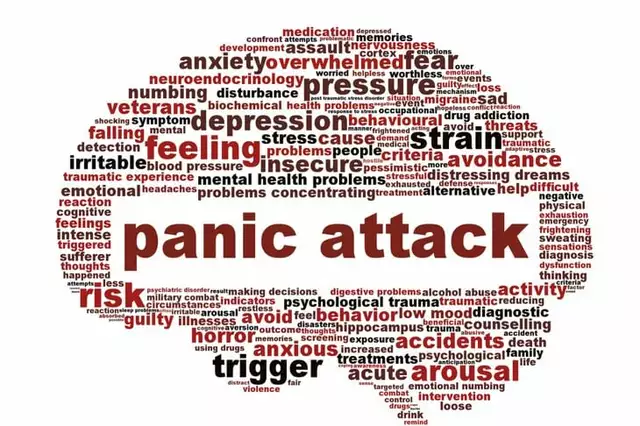Understanding Panic Disorder
Panic disorder is a type of anxiety disorder characterized by unexpected and recurrent panic attacks. These attacks can cause intense fear, physical symptoms, and even lead to avoidance of certain situations or places. In this section, we'll explore the nature of panic disorder, its symptoms, and how it can affect your daily life. By understanding panic disorder, you'll be better equipped to manage it in public spaces.
Panic attacks can be triggered by various factors, such as stress, certain events, or even seemingly out of nowhere. Common symptoms include racing heart, shortness of breath, dizziness, and feelings of impending doom. It's essential to recognize these symptoms and learn how to cope with them to manage panic disorder effectively.
Living with panic disorder can be challenging, especially when it comes to navigating public spaces. The fear of experiencing a panic attack can lead to avoidance of these situations, ultimately impacting your work, social life, and overall well-being. That's why it's crucial to develop strategies to manage your panic disorder and regain control of your life.
Preparation is Key
Being prepared can significantly reduce anxiety and help you manage panic disorder in public spaces. Before venturing out, take some time to plan your day and consider potential triggers or situations that may cause anxiety. This way, you'll be better equipped to handle any challenges that may arise.
Carry a small kit with essential items that can help you cope with a panic attack, such as calming essential oils, a stress ball, or even a small bottle of water. Familiarize yourself with relaxation techniques, like deep breathing exercises or progressive muscle relaxation, which can be helpful in reducing anxiety during a panic attack.
It's also a good idea to inform someone close to you about your panic disorder. Having a trusted friend or family member who can provide support and reassurance in public spaces can make a world of difference.
Recognize the Early Signs of a Panic Attack
Learning to recognize the early signs of a panic attack is crucial in managing panic disorder in public spaces. As soon as you notice symptoms, such as increased heart rate, shortness of breath, or dizziness, take action to prevent the attack from escalating.
Start by implementing relaxation techniques, such as deep breathing exercises or grounding techniques, to help calm your body and mind. Keep in mind that panic attacks are temporary and will eventually pass. Reminding yourself of this can help reduce the intensity and duration of the attack.
If possible, find a quiet and less crowded space where you can focus on calming yourself down. Remember that it's okay to step away from a situation if you need to regain control.
Grounding Techniques
Grounding techniques are an effective way to manage panic disorder in public spaces, as they help you focus on the present moment and divert your attention away from anxiety-provoking thoughts. Here are some grounding techniques you can use during a panic attack:
1. The 5-4-3-2-1 technique: Identify five things you can see, four things you can touch, three things you can hear, two things you can smell, and one positive quality about yourself.
2. Deep breathing exercises: Take slow, deep breaths in through your nose, and exhale through your mouth.
3. Focus on a specific object or point in your surroundings and describe it in detail to yourself.
4. Count backward from 100 by 7s.
Experiment with different grounding techniques and find the ones that work best for you. Remember that practice makes perfect, so don't get discouraged if a technique doesn't work for you right away.
Create a Safe Space
Having a safe space to retreat to during a panic attack can provide comfort and help you regain control. In public spaces, this could be a quiet corner, an empty room, or even a restroom. Identify these areas ahead of time so that you know where to go if a panic attack occurs.
You can also create a mental safe space by visualizing a calming and peaceful place or situation. Focus on this image during a panic attack to help reduce anxiety and bring yourself back to the present moment. Keep practicing this visualization technique, and it will become more effective over time.
Seek Professional Help
While self-help strategies can be beneficial in managing panic disorder, seeking professional help from a mental health expert is often necessary to address the root causes of your anxiety. A therapist or counselor can help you develop coping mechanisms, identify triggers, and provide guidance on how to overcome your panic disorder.
Cognitive-behavioral therapy (CBT) is a widely used treatment for panic disorder, as it focuses on changing negative thought patterns that contribute to anxiety. Your therapist may also recommend medications, such as antidepressants or anti-anxiety medications, to help manage your symptoms. Remember that there's no shame in seeking help, and it's a crucial step in taking control of your panic disorder.
Practice Self-Compassion
Living with panic disorder can be challenging, and it's important to practice self-compassion during your journey toward better mental health. Remind yourself that you're not alone in this struggle and that it's okay to feel anxious or overwhelmed at times.
Celebrate your progress, no matter how small, and don't be too hard on yourself if you have setbacks. Remember that recovery is a process, and it's essential to be patient with yourself as you learn to manage your panic disorder in public spaces.
Stay Connected with a Support Network
Having a strong support network can make a significant difference in managing panic disorder. Share your experiences with friends, family members, or support groups who understand what you're going through. They can offer encouragement, advice, and a listening ear when you need it most.
Connecting with others who have panic disorder can also provide a sense of camaraderie and remind you that you're not alone in your struggles. Online forums, local support groups, and social media platforms can be excellent resources for finding like-minded individuals who can offer support and understanding.








Comments
Rajeshwar N.
April 29, 2023Looks like the guide tries to sound helpful, but honestly it reads like a generic checklist that anyone could copy‑paste. The whole ‘carry a kit with essential oils’ advice is overrated; most people end up feeling more self‑conscious than soothed. You also ignore the fact that avoiding triggers isn’t always feasible in crowded urban environments. While grounding techniques are mentioned, the article never explains why the 5‑4‑3‑2‑1 method works from a neurobiological standpoint. Bottom line: it’s more hype than substance.
Louis Antonio
May 13, 2023Let me break it down for you: panic attacks aren’t some mystical monster you can tame with a stress ball alone. The post glosses over medication, yet many sufferers rely on SSRIs to keep the physiological surge in check. Also, “inform someone close” sounds nice, but if you’re constantly leaning on the same friend, you’re just shifting the burden. Deep breathing? Sure, but only if you’ve mastered diaphragmatic breathing first-otherwise you’ll hyperventilate. And don’t think “visualize a safe space” is a cure; it’s a distraction that can backfire when the anxiety spikes. So yeah, the article feels half‑baked.
Kyle Salisbury
May 28, 2023Coming from a small town in the Midwest where public places are sparse, I’ve learned that the strategies you choose must fit the environment you actually live in.
The article’s suggestion to scout quiet corners works well in a big city café but falls flat when you’re in a tiny grocery store with only a single aisle.
In my experience, the most reliable anchor is a personal, culturally resonant cue, like humming a childhood lullaby that your grandparents used to sing.
That tiny auditory reminder can cut through the panic surge faster than any external grounding exercise.
I also find that the 5‑4‑3‑2‑1 method, while popular, feels artificial if you’re not used to cataloguing senses on the fly.
Instead, I practice a simple “one‑thing‑at‑a‑time” focus: I pick the nearest object, describe its texture, color, and temperature in my head, and let the rest fade.
When it comes to medication, I’ve been prescribed a low‑dose SSRI that stabilises my baseline anxiety, letting the behavioral tools actually work.
Never underestimate the power of a discreet inhaler; a quick spritz of peppermint oil can give a sensory jolt that resets your nervous system.
I also keep a small notebook with a list of coping phrases in my native language, because hearing my own words feels grounding in a way English sometimes doesn’t.
The article mentions informing a close friend, but my family lives far away, so I rely on a text‑based safety net-a trusted contact who knows to call me if I text “SOS”.
That digital lifeline is less intrusive than a constant physical presence yet provides that safety net you need.
Another tip that’s missing is the role of regular physical activity; a short walk before heading into a crowded space can lower baseline cortisol levels.
I schedule a 10‑minute brisk walk around my block as a pre‑flight routine, and it makes the transition to the bus much smoother.
Lastly, I’ve found that mindfulness apps calibrated to my cultural music preferences make the breathing exercises less sterile and more personal.
All of these tweaks are small, but together they transform the generic advice into a lived, adaptable practice.
So if you’re reading this guide, consider which of these culturally specific hacks you can slot into your own routine for a real edge.
Angie Robinson
June 12, 2023Honestly, the whole “create a safe space” advice feels like a Band‑Aid for a deeper wound.
Emmons Kimery
June 29, 2023Hey, you’ve got a solid foundation here and that’s something to be proud of 🌟. Remember, it’s totally okay to lean on the coping kit you’ve built, even if it feels a bit cheesy at times 😅.
If you ever feel the panic creeping in, try the grounding list while picturing your favorite happy memory-your brain loves that contrast.
Keep communicating with your support crew; a quick “I’m okay” text can do wonders for your confidence 📱.
You’re doing the work, and every small victory adds up, so keep moving forward with kindness toward yourself 💙.
Write a comment